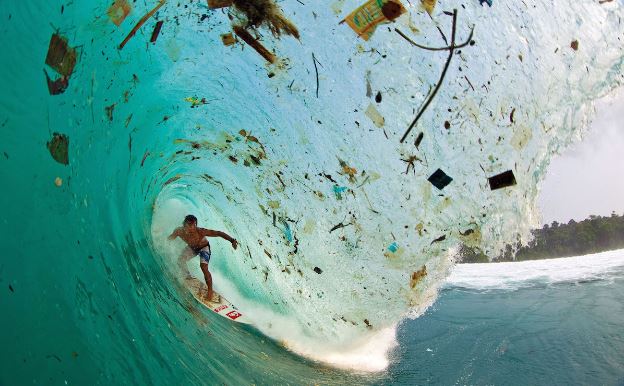
Grappling with Ocean Plastic Pollution: Past, Present and Future. (Monterey Bay Aquarium)
The Oceanic Society reports that “Plastic pollution is one of the greatest threats to ocean health worldwide…between 4 and 12 million metric tons of plastic waste enter the ocean each year, enough to cover every foot of coastline on the planet. And that amount is expected to more than double in the next 10 years…In the ocean, plastic pollution impacts sea turtles, whales, seabirds, fish, coral reefs, and countless other marine species and habitats. It also mars otherwise beautiful beaches, coastlines, and snorkel and dive sites worldwide, even in remote areas such as Midway Atoll. One of the reasons that plastic pollution is such a problem is that it doesn’t go away: “plastics are forever.” Instead, plastic debris simply breaks down into ever-smaller particles, known as microplastics, whose environmental impacts are still being determined.”
The scientific journal Plos One estimated in 2014 that “at least 5.25 trillion plastic particles weighing 268,940 tons are currently floating at sea… Our estimates suggest that the two Northern Hemisphere ocean regions contain 55.6% of particles and 56.8% of plastic mass compared to the Southern Hemisphere, with the North Pacific containing 37.9% and 35.8% by particle count and mass, respectively. In the Southern Hemisphere the Indian Ocean appears to have a greater particle count and weight than the South Atlantic and South Pacific oceans combined…”
The Center for Biological Diversity notes that “Plastic never goes away. And it’s increasingly finding its way into our oceans and onto our beaches. In the Los Angeles area alone, 10 metric tons of plastic fragments — like grocery bags, straws and soda bottles — are carried into the Pacific Ocean every day. Today billions of pounds of plastic can be found in swirling convergences making up about 40 percent of the world’s ocean surfaces. Most ocean pollution starts out on land and is carried by wind and rain to the sea. Once in the water, there is a near-continuous accumulation of waste. Plastic is so durable that the EPA reports “every bit of plastic ever made still exists.” Due to its low density, plastic waste is readily transported long distances from source areas and concentrates in gyres, systems of rotating ocean currents. All five of the Earth’s major ocean gyres are inundated with plastic pollution. But it’s not limited to the gyres; studies estimate there are 15–51 trillion pieces of plastic in the world’s oceans — from the equator to the poles, from Arctic ice sheets to the sea floor. Emerging research suggests that not one square mile of surface ocean anywhere on earth is free of plastic pollution.”
A Scientific American/Reuters article by Will Dunham states that “China was responsible for the most ocean plastic pollution per year with an estimated 2.4 million tons, about 30 percent of the global total, followed by Indonesia, the Philippines, Vietnam, Sri Lanka, Thailand, Egypt, Malaysia, Nigeria and Bangladesh. The United States was the only rich industrialized nation in the top 20, and it ranked No. 20. Coastal EU nations combined would rank 18th.”
Ecowatch notes that:
- At least 8 million tons of plastic enter the oceans each year. That’s similar to emptying a garbage truck of plastic into an ocean every minute;
- There is more microplastic in the ocean than there are stars in the Milky Way;
- 322 million tons of plastic were produced in 2015—the same weight as 900 Empire State Buildings (which is made of granite and steel);
- 60-90 percent of marine litter is plastic-based;
- More than 50 percent of sea turtles have consumed plastic;
- The average U.S. citizen consumes 167 plastic water bottles each year, but recycles just 25 percent of them;
- The amount of plastic in the world’s oceans could increase by a factor of 10 in the next decade.
Frank Vernuccio serves as the editor-in-chief of the New York Analysis of Policy and Government.

















Follow Us